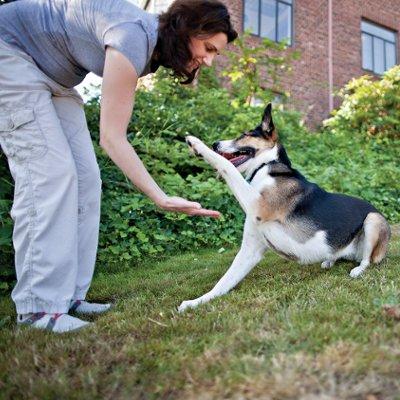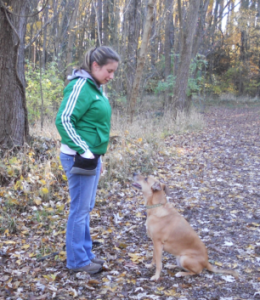Successful training involves finding the behaviors that you DO want (i.e. sit politely) and rewarding them for occurring. Behavior that gets rewarded is repeated!
As a dog trainer, I’ve seen my fair share of dogs and families that need some help. Usually the interaction goes something like this: the owner tells me all the behaviors that they don’t like (the dog jumps, barks or pulls on a leash, for example), and we spend time figuring out what behaviors we want instead (sitting, being quiet or walking nicely on a leash). Then we develop a plan to train the dog to perform these desirable behaviors. While this type of training is fun and rewarding, there is a whole other type of training that I take part in- training my foster dogs.
As an active volunteer with several rescues, I often foster shelter dogs while they’re waiting to be adopted. The dogs come from all walks of life and are different sizes, breeds, ages, etc. In most cases, they all come with a history that I don’t know about and I don’t have a previous owner to ask.
 This beagle mix came to me at the age of 12 years old. She had lots of history that I didn’t know about! Most come with some behavior problems—that’s usually how they ended up in the shelter to begin with. So any training that I can do while they live with me is monumentally helpful. Not only does it help the dog get adopted, it also helps the dog’s chances of staying in that new home!
This beagle mix came to me at the age of 12 years old. She had lots of history that I didn’t know about! Most come with some behavior problems—that’s usually how they ended up in the shelter to begin with. So any training that I can do while they live with me is monumentally helpful. Not only does it help the dog get adopted, it also helps the dog’s chances of staying in that new home!
However, unfortunately, with foster dogs there are unique obstacles in training. First, I never know for sure how long I have with the dog. In my fostering history, I had a cocker spaniel mix for two days, and a chocolate lab mix for close to a year. That means I have to create goals and determine the priorities for that dog. Even more importantly, I have to be flexible when my goals can’t be met.
When I started with the cocker spaniel, I had big goals of counter-conditioning him to crate training. He was terrified of being in the crate. As you can imagine, we didn’t get very far in two days. However, just as important, I was able to meet a different goal- have him feel comfortable taking treats from my husband. 
It didn’t take long to train this chocolate lab mix, Joey, to be polite with other dogs. On the other hand, the chocolate lab mix that I fostered for close to a year had very few behavior issues. Since he was a pretty big dog, my main goal for him was to train appropriate play behavior with other dogs. Six months later, I trained that and several tricks because I had a lot of extra time with him.
Another obstacle with training foster dogs is that the time is cut even shorter because you need to acclimate the dog to the new surroundings. 
This momma dog was extremely cautious letting me come near her for the first 2 weeks of her staying in my home.
When I receive a new foster dog, I don’t get to train new behaviors for at least a week or more. This first chunk of time is just to acclimate the dog to my home, new people and new surroundings. For some dogs, this is a quick process, while other dogs take several weeks to start to feel comfortable.
For example, I fostered a Shepherd mix and her 7-puppy litter, and it took over a week before the Momma dog let me come near her-- she was very protective over her puppies.
When the dogs do get acclimated, I can start training, but I have to deal with whatever past history the dog comes with. Whether it is from lack of socialization or previous abuse, some foster dogs have fear-based issues.
Without overcoming these fears, the dog might not be able to begin learning other appropriate behaviors, so it’s important to deal with those first. For example, I fostered a coonhound that was so afraid of her resources (food, etc) being taken away that she attacked other dogs if they came near. Dealing with this fear was the first step before I could train other appropriate behaviors.
 Zoey was a very easy foster. A little crate-training and we were set!
Zoey was a very easy foster. A little crate-training and we were set!
There is no cookie cutter for foster dogs. Some dogs are super easy while others are more difficult. A dachshund mix that I fostered needed a little help with crate training, but other than that, she was perfect. On the other hand, I once fostered a 3-legged beagle that spent a large chunk of time learning to walk comfortably on a leash.
Some dogs have physical or health issues that need to be dealt with before training can really begin. The 3-legged beagle obviously had physical limitations that made training unique. I also fostered a puppy that needed to be socialized, but due to a health complication in her intestines, we needed to make sure she was eating, resting and keeping warm rather than socializing her to new textures and experiences.  Working with this dog, Nutmeg, involved more health care than training.
Working with this dog, Nutmeg, involved more health care than training.
A lot of people assume that when I foster dogs, I get to teach them things like “sit”, “down”, “shake”, or other behaviors that might make them more “exciting” to potential homes. Realistically, training a foster dog means bringing a dog into my home, providing a calm and comfortable place while the dog gets acclimated, making sure that the dog feels he/she can trust me, and then working on whatever the dog gives me.
Because each dog is so different, I really never know what to expect to train. To make matters more difficult, we often have very little history to go on—we don’t have previous owners to tell us how or why the dog might react in certain situations. 
This former foster, Frank, had a brain condition called hydrocephalus that impacted how I worked with him. When he was adopted, I was able to keep in touch with his new parents and it still fills my heart hearing his updates!
Although training foster dogs can be tricky, it’s also extremely rewarding. Even if the only thing I can train a dog is that he or she can trust me enough to snuggle with me on the couch, I have made him or her more adoptable because he or she is learning to trust people.
Every little bit of training helps the dog get adopted, and even more important, helps the dog stay in their new home. It’s a beautiful transition to watch as a dog leaves his “homeless” days behind. It’s even greater when he can start learning behaviors that establish him as a happy well-behaved member of the family.
Eventually the foster dogs always find new homes and saying good-bye to them is incredibly difficult. Although, I’m always comforted by the thought that I know the foster dog has left an imprint on my heart, and I’ve left an imprint on his life by working with him in whatever way that I could.



